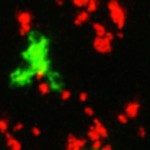Link to Pubmed [PMID] – 19454693
J. Immunol. 2009 Jun;182(11):6959-68
Understanding the mechanisms leading to effective priming of lymphocytes with regulatory properties is crucial for the manipulation of immune responses. CD8alphaalpha(+)TCRalphabeta(+) T cells are a special subset of innate-like lymphocytes that have been shown to be involved in immune regulation. These cells can recognize self-peptides in the context of a class Ib molecule, Qa-1. How self-Ags are processed in the Qa-1 pathway and presented to CD8alphaalpha(+)TCRalphabeta(+) T cells is not understood. In this study we demonstrate a cross-presentation pathway by which bone marrow-derived dendritic cells (DCs) capture apoptotic CD4(+) T cells and process and present TCR-derived peptides in the context of Qa-1 to prime CD8alphaalpha(+)TCRalphabeta(+) T cells. The priming ability of the DCs is enhanced following TLR signaling using TLR3, TLR4, and TLR9 agonists. DC-mediated cross-presentation is inhibited in the presence of endosomal and proteasomal Ag-processing antagonists. Importantly, DCs loaded with apoptotic T cells prime CD8alphaalpha(+)TCRalphabeta(+) T cells in vivo, which in turn provides protection from CD4(+) T cell-mediated autoimmune disease. These data provide a key insight related to processing and presentation of self-Ags in the Qa-1 pathway for priming of CD8alphaalpha(+)TCRalphabeta(+) T cells and have implications for a DC-based immunotherapeutic approach to inflammatory diseases.

